Motorcycle Investor mag
Subscribe to our free email news
This riding life
David
Langridge unwraps 70 years in the saddle
November 2025
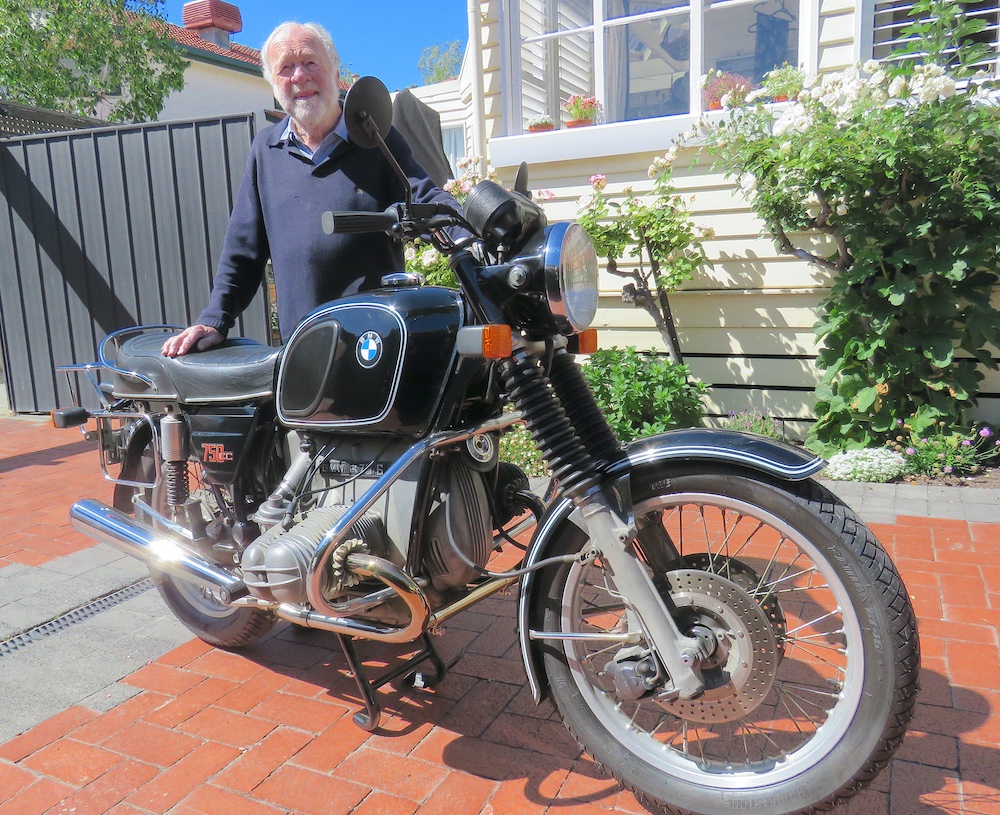
Above: David
Langridge.
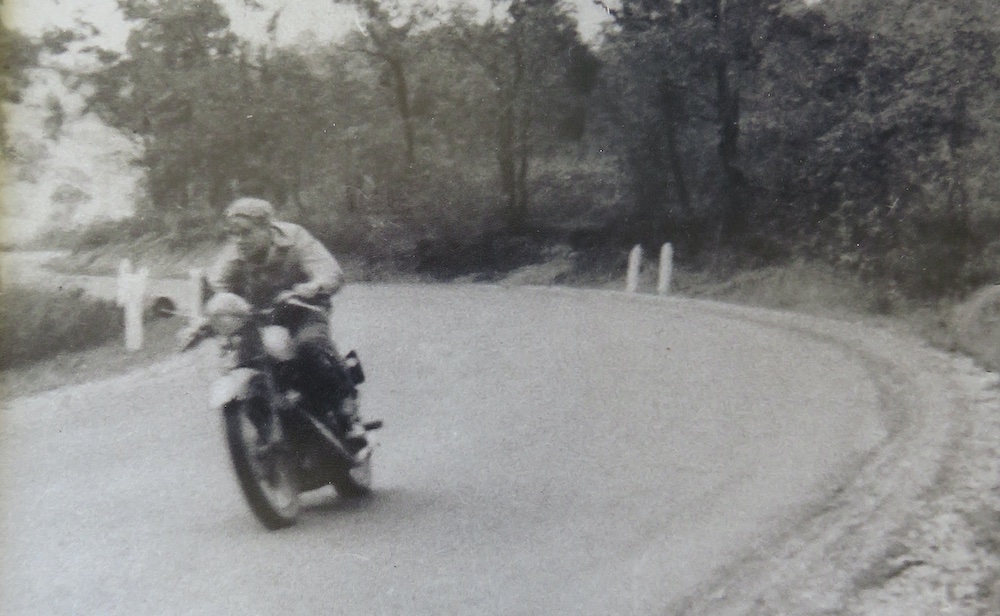
Above: it's January, 1950.
Young Langridge is on a BSA 350 and looking for
trouble.
At school I had a friend who lived
at Wattle Glen (north-east of Melbourne,
Australia) which in those days was really bush. I
used to stay most weekends and school holidays. In
January 1950, he purchased an old BSA 350 for two
pounds and this gave me my first ride on a
motorcycle. I had no idea the influence that bikes
would have on my life over the next seventy plus
years. We rode the dear old thing all over the
place. No helmets, no rego, no licences, happy
days!
Eventually we wore out the rear tyre and didn't
have the money to buy another one.
When I was 16 I would go to Tracey’s Speedway in
the western suburbs. I would head off on my own by
tram to the city, then catch another tram to the
speedway. I loved the noise, excitement, the
racing and the great people who were there. I will
never forget the sight of Frank Sinclair on the
Vincent outfit who seemed to win everything.
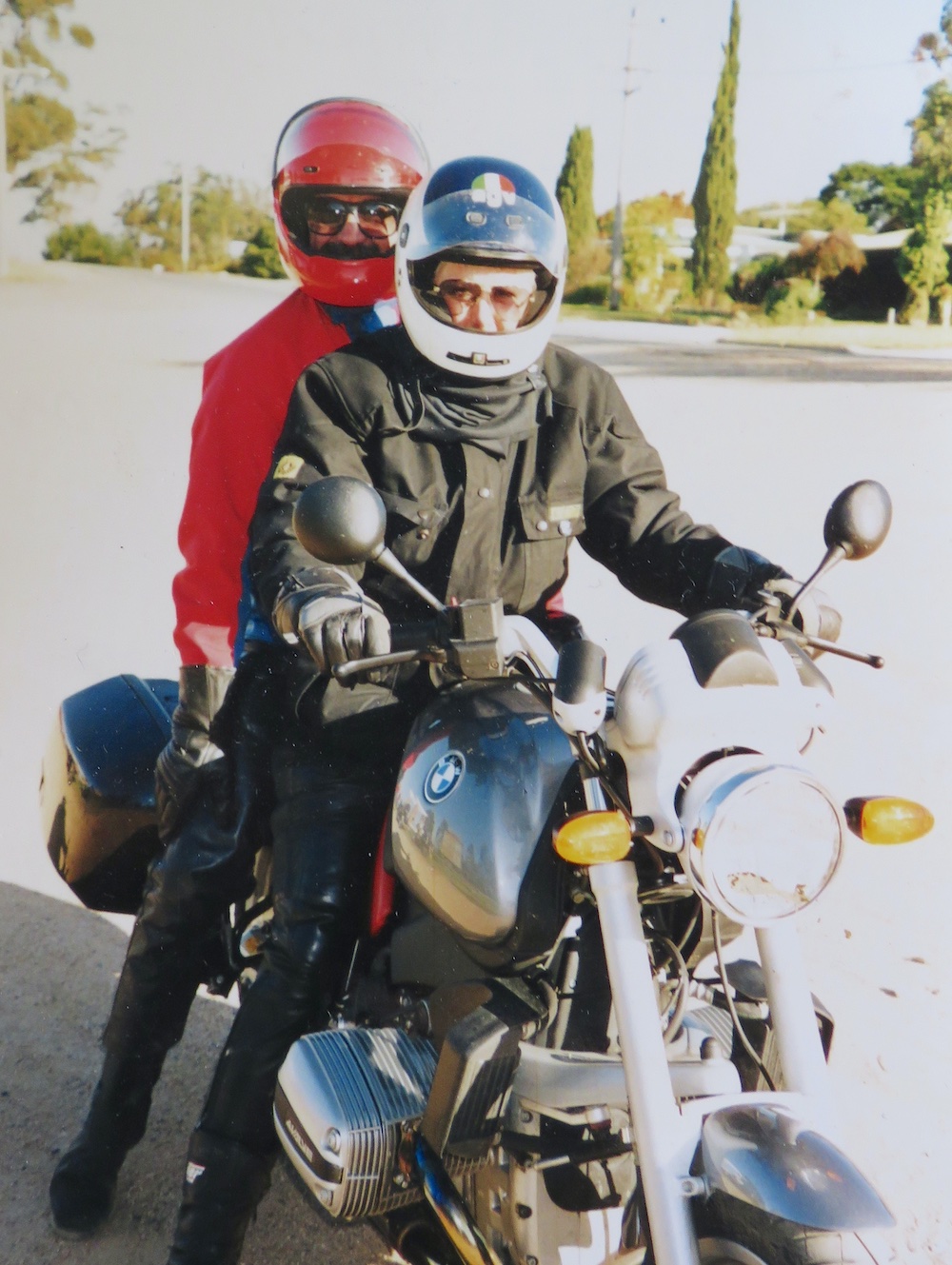
Above: Jen Langridge at the controls, with notable engineer/racer Lindsay Urquhart on the pillion throne.
Over the next few years, even
though I was a ‘man about town’, I still
maintained my interest in motorbikes. It was over
that time I was lucky to meet the perfect woman
who is still with me after 63 years. Jen (above)
quickly became involved in motorcycling with me
and for many years rode pillion. She also rode
dirt bikes as well as having her own road bike.
One summer in the late 1960s we went to stay with
Julian and Beth Brown, who were old friends, at
their lodge at Falls Creek. When we got there
Julian told me that his friend Alex Milledge had
fallen off a bike and gone home with a sore leg.
Luckily for me, he left a Yamaha and a Hodaka for
Julian to go trail riding. Off we went, and for
day after day and had a ball. We saw all the
drover huts dotted all over the mountains, in fact
we went to places you would not be allowed to go
to today.
As soon as I got home, I went to Milledges and
Bruce Johnston sold me a Yamaha trail bike_ 90cc
of raw power. I discovered a neighbour had also
just bought a motorcycle and we rode most
weekends.
Then I started to move up the ladder of power,
including Yamaha 125 and 250, Maico AW250 and 400,
Ossa SDR250 and Super Pioneer 250, Honda XR250 and
XR500.
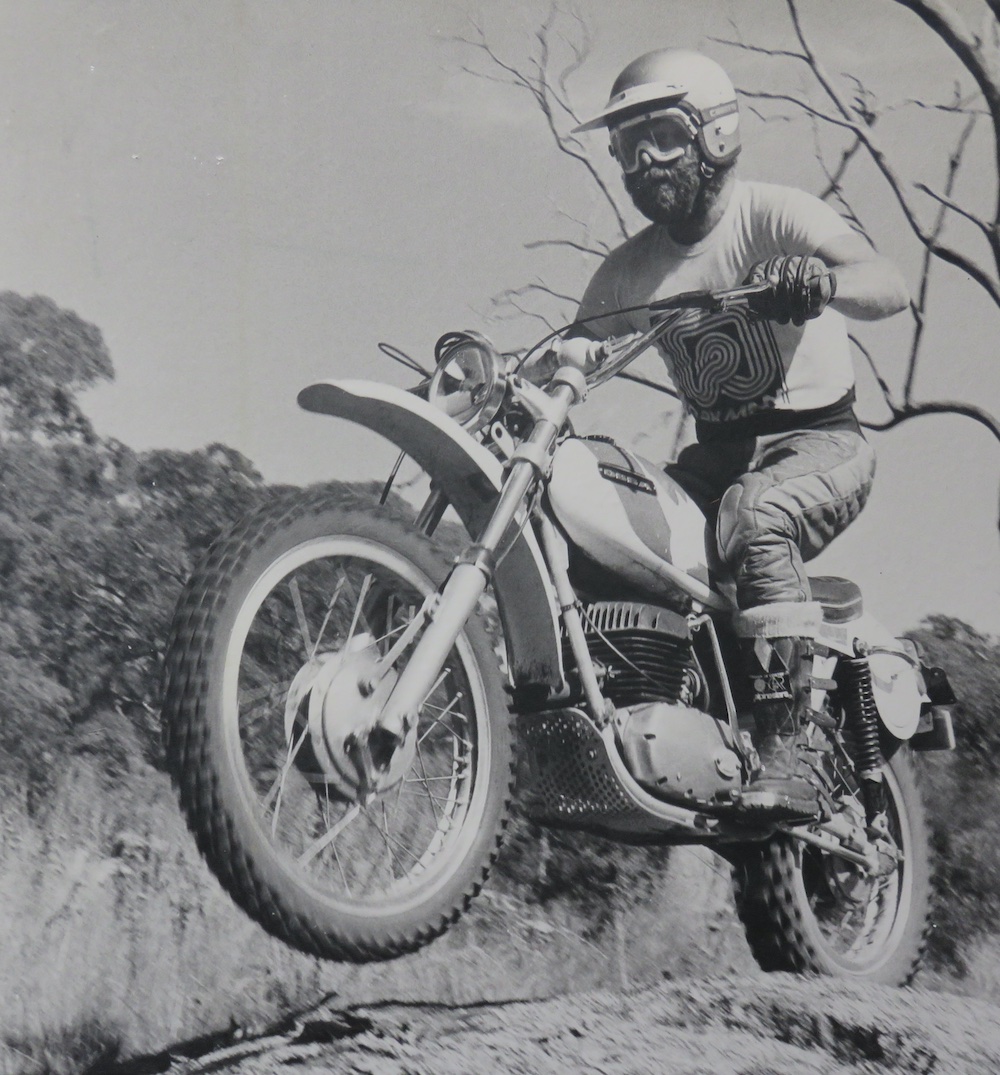
Above: airborne on an Ossa – there are much worse places to be...
I competed in some enduros with a
remarkable lack of success. My last was at Possum
Hollow, with two laps of impossible terrain
knee-deep in mud. It had over 200 entries of which
about seven finished. I did one lap and retired
from the enduro scene with some dignity left.
We then purchased a property at Mt Tallarook so we
could enjoy the day with our families while we
rode in the state forest.
***
Note: David is clearing out his motorcycle book
collection, spanning several decades. You can
see the auction here.
***
Somewhere along the way, I more less fell into the
motorcycle auction business – at least for a
while. In 1979 Merv Cooper, who sold classic bikes
out of Croydon, said he had a few surplus machines
and would I auction them for him? I must admit
this was a pioneering moment in the local
motorcycle scene. I hired the Brighton Town Hall
and held my first auction on October 6, 1979. It
was very modest, 11 bikes and 92 lots of parts.
Surprisingly, it was a great success. Over the
next six years I had a further six auctions in
Melbourne and one in Sydney.
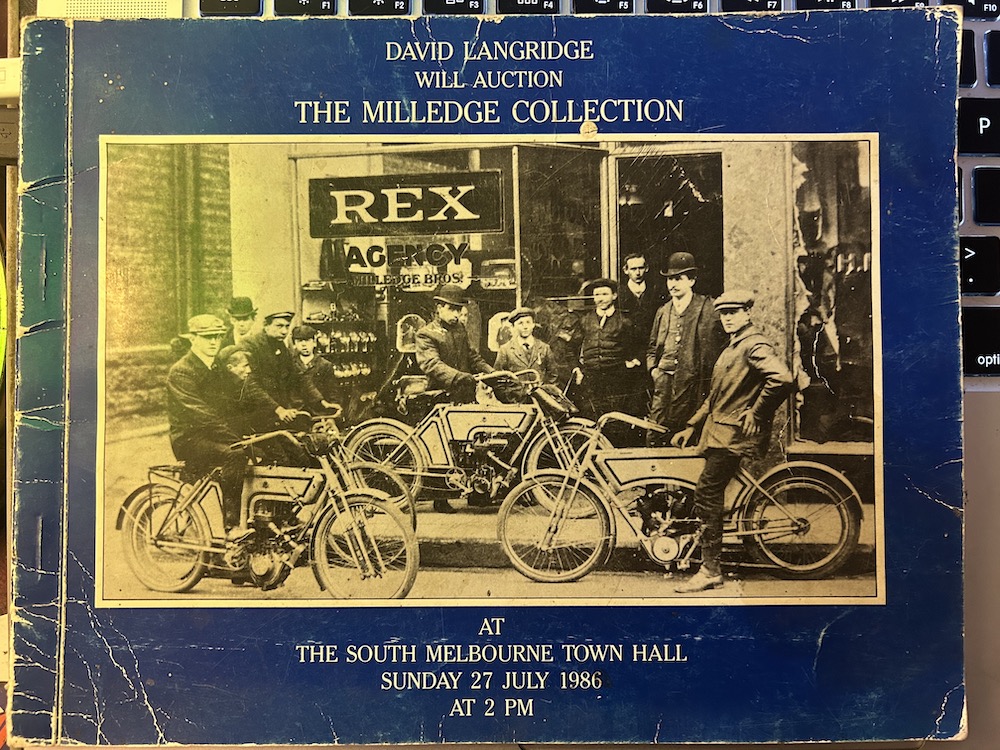
Above: the 1986 Milledge
auction was a major event.
This also led to the Milledge
auction at South Melbourne Town Hall where I sold
Alex’s personal collection of bikes. I also held a
successful auction for Reg Hunt with part of his
car collection.
There was a funny little aside with the first
auction. The keeper of Brighton Town Hall was
nervous about having a motorcycle event, even more
so when he saw a car park full of big motorcycles
and riders in leathers. “The place is full of
bikies,” he explained with some alarm. “Should I
call the police?” The police station was just
across the road and I said no, we would be fine.
Everyone had a great time and a couple of people
from one of the rider clubs came up to thank me. I
pointed out the keeper and asked they did the same
for him – which they did. We were fine after that.
About this time Merv sold me a 1938 BSA Empire
Star 350, my first classic bike, which led to my
first classic rally was in Parkes.
In 1985 I joined the Classic Motorcycle Club
of Victoria. It was an experience to meet
such a fine group of people with similar
interests. I have been President twice for a total
of about five years, and was granted a life
membership in 1997. During my years with the club
I rode in approximately 120 rallies and in 1996 my
wife Jen (above) and I headed a committee that
organised a rally to celebrate the 25th
anniversary of the club. The rally ran for a week,
covered approximately 1800km and was a roaring
success. We had 120-plus people and 90
motorcycles.
The mid-eighties was a busy period. Again in 1985,
eight of us decided to do a trip in the Northern
Territory and north Queensland comprising 10 days
exploring wonderful country. We sent the bikes by
train to Alice Springs, the starting point. From
there it was north to Burketown, keeping to small
roads and cattle tracks. I was on an XR250 Honda
that never missed a beat.
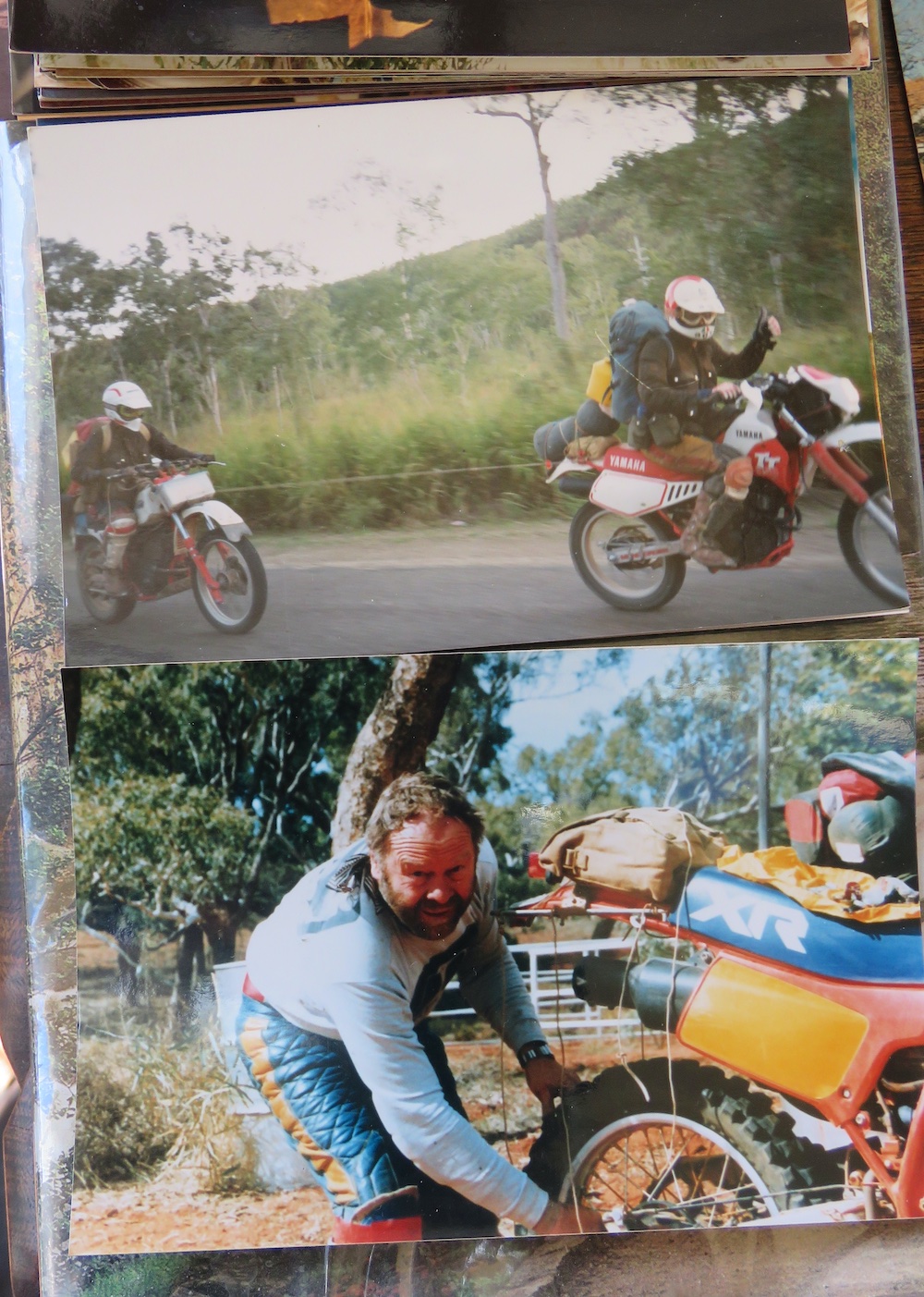
Above: memories of the NT-Qld ride. That's David and his XR250 in the lower pic.
When we left Burketown heading to Normanton one of the KTMs had a catastrophic engine failure. What to do? We decided to tow the bike to the Burke and Wills five-ways roadhouse. It was late afternoon and getting dark. I got separated from the others and spent a couple of stressful hours not knowing if I was on the right track, dodging very large Brahman cattle that were everywhere. It would have been easy to start to panic but decided I was too tired. Never have I been happier to see the lights of the roadhouse in the distance, which they had kept open late for us.
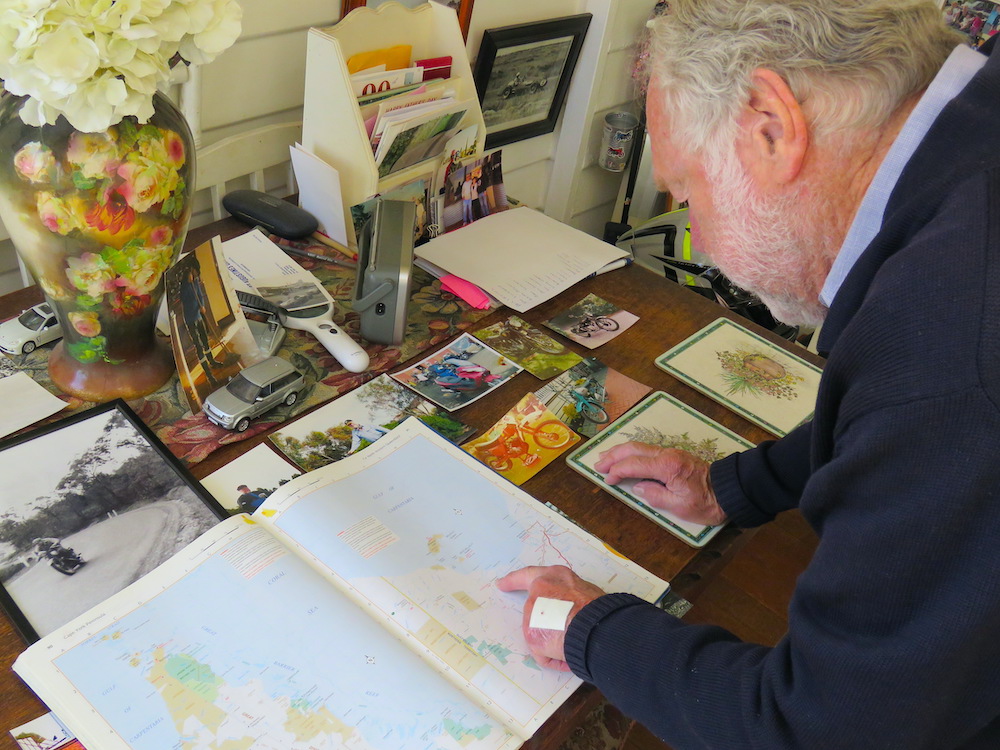
Above: retracing the route of the big NT-Qld ride.
Next day we rode to Cloncurry and
found there was a goods train leaving that night
that would take us to Hughenden to buy another
bike. The train trip was a story all of its own –
suffice it to say we got there safely. It was then
decided we would ride to Mackay, cross-country.
That was the final leg of a journey which left us
with a wealth of memories.
Moving on a couple of decades and Peter Stevens
Motorcycles in 2002 had a serious fire in what was
then its Elizabeth Street headquarters. When the
rebuild was completed, it was decided to have a
reopening event. As it was MotoGP time, Vince
Chiodo (then one of the partners in Peter Stevens)
arranged for MotoGP champion Valentino Rossi to
drop in. I was asked by Vince to be MC of the day
– he told me that as Valentino was on a tight
schedule there would not be time for autographs.
There was a large crowd in attendance and, after a
short time, Valentino said he was enjoying himself
so much he cancelled his next commitment and
stayed. There was a mad rush for people going to
the accessory department upstairs buying helmets
to have them signed. The time I spent with
Valentino was terrific. He was great to talk to
and full of enthusiasm. Plus, he won the MotoGP on
the Sunday!
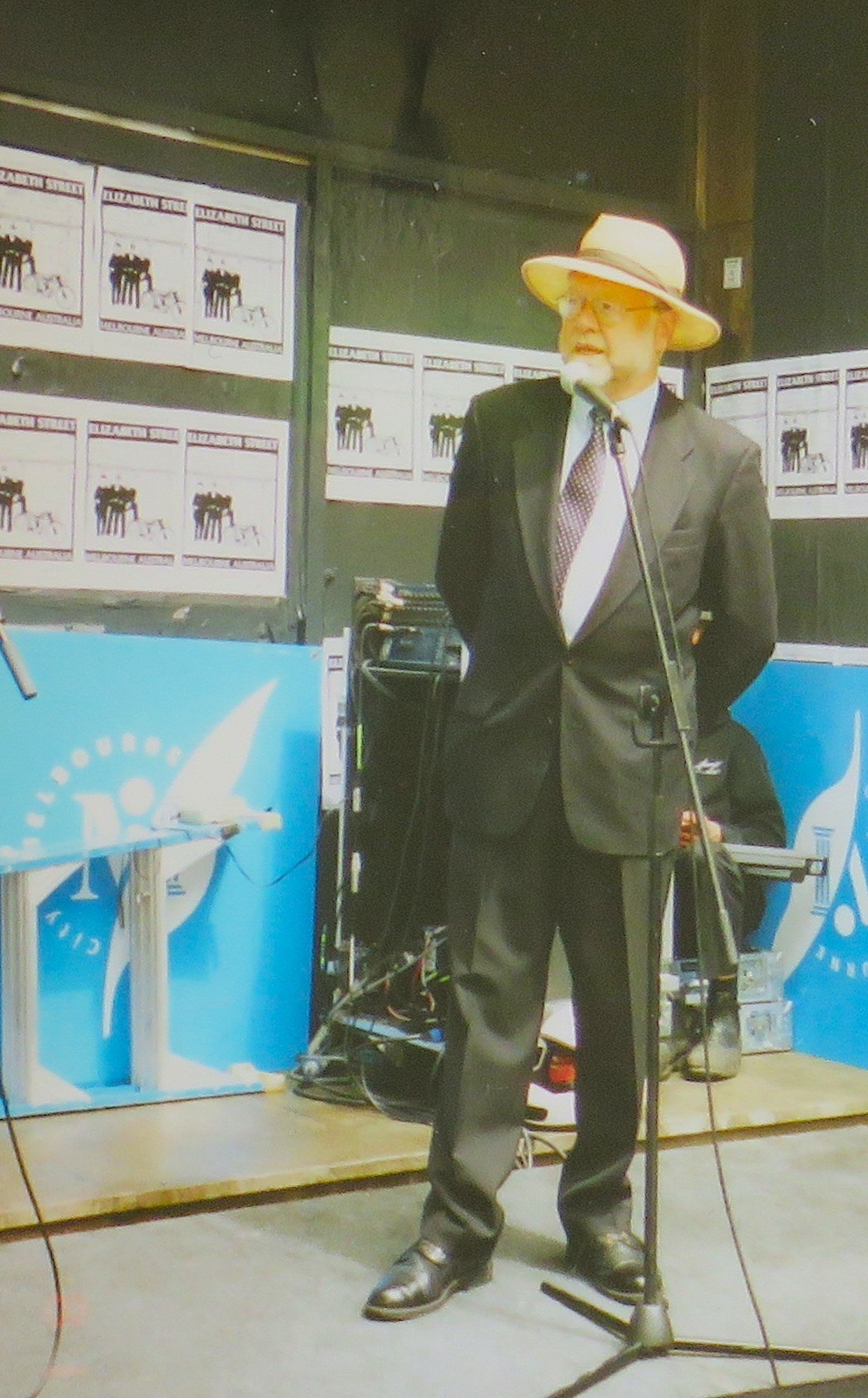
Above: playing the dapper MC at
the Elizabeth Street motorcycle precinct 100th
anniversary celebration.
In 2013 I was approached by the
Chiodo family to be on the committee organising
the centenary of motorcycling in Elizabeth Street.
The committee was Mary Chiodo, Ray Isles of the Classic Motorcycle Club
in Victoria and me. This took approximately
twelve months to organise and was a huge success.
The impressive main display was a motorcycle model
for every year of the century, while others
covered racing bikes, dirt bikes etcetera. I had
the job of MC for the day and happily talked from
8.30am till 3.00pm. David Beanham from Modak
Motorcycles – then the longest-established
specialist shop in Australia – said it was just
like old times with the place packed. It was one
of the best days I have ever had, and the goodwill
and fellowship of the crowd was fantastic.
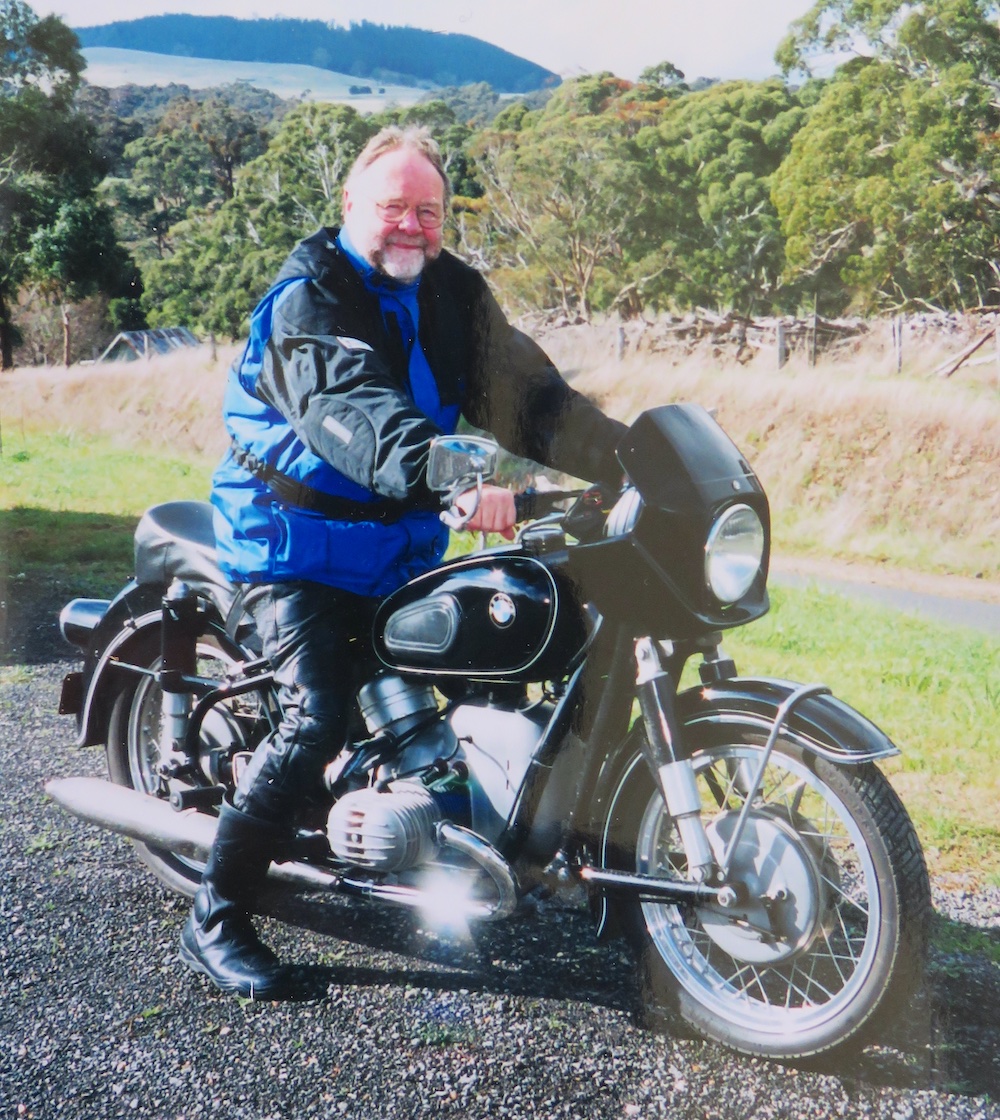
Above: David with his BMW R60.
The road bike stable over the
years consisted of:
BSA Empire Star
BSA B31
BSA DBD34 Gold Star
Vincent Comet
Ambassador
BMW R60
BMW R65
BMW 80
BMW 75/5
BMW 75/6
BMW R100RS
Suzuki Burgman 400
Hyosung GT650
My favourite motorcycle over the 70 years I rode?
That is so difficult – there are a couple of
categories.
I spent the first 20 years of my riding life in
the bush and the Maico AW250 I had was an absolute
bullet. Somehow Keith Stacker managed to get it
registered and I didn’t ask too many questions. He
was magic with two-strokes. He tuned it and asked
me where I wanted the power, and I said in the
middle. It was perfect.
I’ve had several BeeEms and the R75/5 did
everything I wanted. It felt as though I did a
million kays on it and there was never a second of
trouble. And it was nice to ride and had a sweet
spot at 110km/h.
Ed’s note: though David
has relinquished riding, it’s clear this remains a
decision – even at age 90 – he finds painful. Roll
up to his house on an air-head boxer BMW, such as
the 1975 R75/6 at the top of the story, and he
makes protests that suggest he just might snatch
the keys off you…
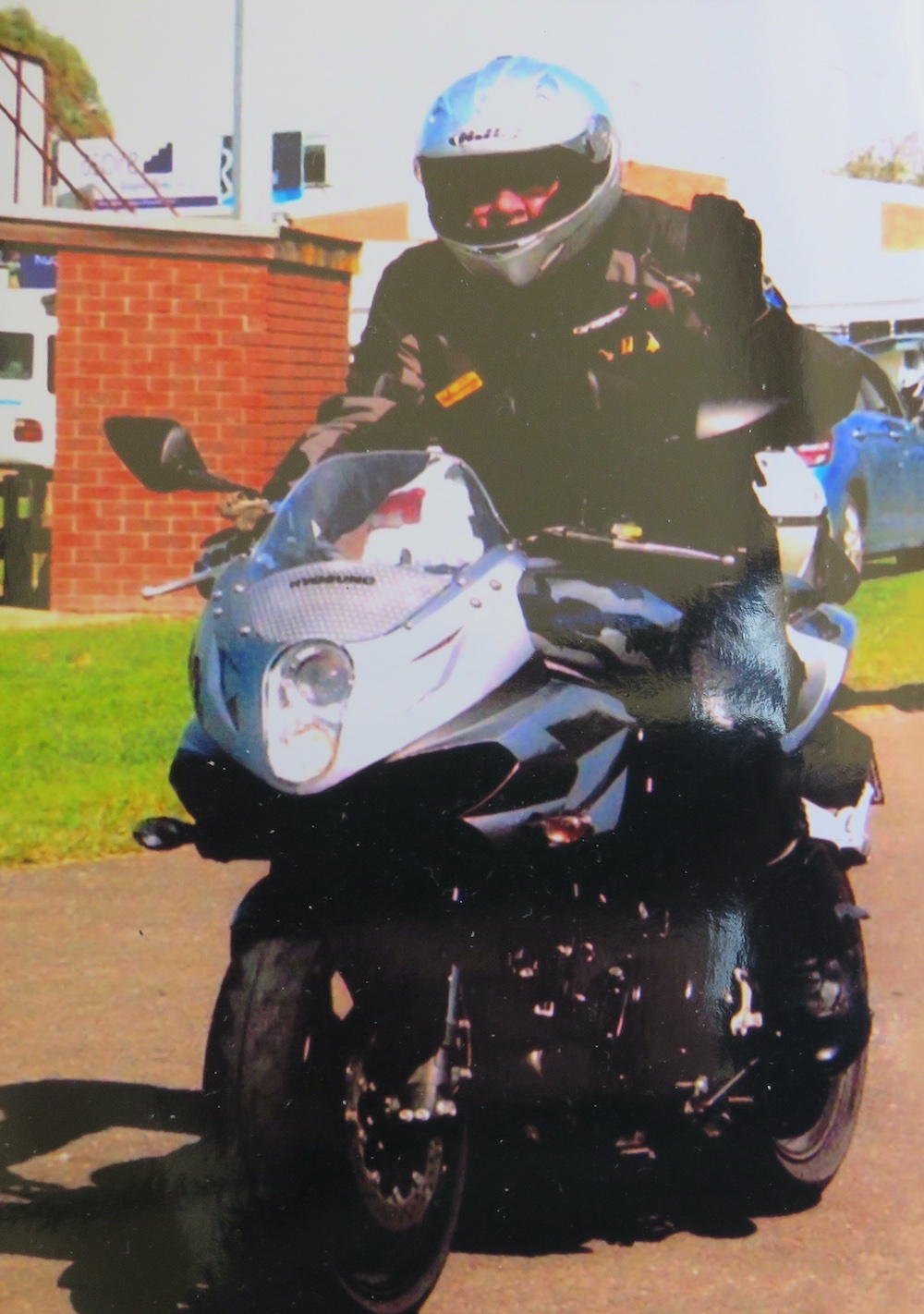
Above: it's 2020 and David is on his Hyosung 650, signing off his riding career some 70 years down the road.
***
David is clearing out his motorcycle book
collection, spanning several decades. You can
see the auction here.
***
And the cars
David has also had a remarkable insight into
the sharp end of the car racing world…

Above: with motor racing royalty, at Sandown. Langridge at left with John Surtees and Stirling Moss.
My interest in Grand Prix racing –
cars and motorcycles – began in the late 1940s at
school.
I started buying The Motor, Autocar,
The Motorcycle and Motorcycling
magazines every week from the enthusiasts Mecca,
the Technical Bookshop in Swanston Street. It was
lucky I found that this business was owned by the
father of a friend at school. We enthusiasts
relied on print as there was no TV and there was
never anything on the radio. My heroes were
Ascari, Farina , Fangio etc.
I managed to get my father to take me regularly to
the races at Fishermens Bend, which was a
wonderful time for a boy who loved racing. At this
stage we lived near the corner of Orrong Rd and
High St, Armadale (Melbourne, Australia). A motor
business known as AF Hollins was located in High
Street, just around the corner.
When I was passing one day, aged 18, I saw in the
windows a Grand Prix Ferrari on display. It turned
out to be Alberto Ascari’s World Championship car
from 1952. As I had my nose pressed up against the
window, a chap inside beckoned me to come in as he
could see my enthusiasm about the car. We talked
for some time. He then introduced himself to me –
lo and behold it was Lex Davison, the owner of the
car. He was at the time one of Australia’s premier
drivers who raced in the Tasman series and Formula
1 world circuit.
Back then I didn't understand the effect this
would have on my life. Over the next few years I
would call into Hollins to see the cars and chat
with the people who worked there. There was always
something going on and plenty of things to see.
In 1956 Lex called me and said, “You had better
come into the garage.” When I got there I nearly
fainted with disbelief, because there with Lex
were Reg Parnell, Peter Whitehead and Ken Wharton,
three of my heroes. Lying around the garage were
two Super Squalo Ferraris, plus a 750 Monza, and a
Maserati 250F! There was also a Cooper Climax
1500, which was the first monoposto car Cooper
made. No body knew why it was there and it was
consistently in the way.
They were all there for the 1956 Australian Grand
Prix to be held at the old Albert Park circuit.
They seemed a bit disorganised and asked if I
could help out by taking some of the equipment to
the circuit for practice. I said yes and was told
to be back at the garage by 8.00am the next day.
When I got there I couldn’t believe what I saw–
all the cars were out in High Street and they
drove the bloody things down to the circuit. It
was quite a convoy: three Ferraris, a Maserati and
my breathless old Citroen Light 15. I will never
forget the noise as they all changed down to go
round into Chapel Street.
The police had great difficulty with dealing with
what was happening and there was much yelling and
shouting. As Reg Parnell said to me, “What Is all
the fuss about? We drive them to the circuits in
Europe.”
Moving forward to 1958 and I was ‘loaned’ to
Arnold Glass who had bought the Ferrari Squalo
driven by Reg Parnell in 1956, to race at Albert
Park. As a tow car he gave me a Packard Clipper.
It looked like an aircraft carrier on wheels, and
was the first automatic I had ever driven. First
gear got 5 miles per gallon, second gear 10. It
was a perfect tow car, with bags of power and
enough room in the boot to take all the gear.
Practice went well with Arnold about half way down
the field. John McMillan, the mechanic, was
getting ready for the race when Arnold appeared
with a press photographer who wanted a cockpit
shot. He was going to come to regret this, as in
those days all the cars were push start. We were
pushing and pushing to no avail. They then dropped
the flag and we were in the middle of the chaos of
a race start. I think Brabham, who started from
the back of the field, missed us by inches! The
silence that followed was only broken by Arnold
standing up in the car and screaming abuse. When
John shut the bonnet he had neglected to put the
ignition leads on after changing the plugs...
Next move was the 1962 race at Sandown. This time
I was with Reg Parnell and the Yeoman Credit team
of Cooper Climax cars driven by John Surtees and
Roy Salvadore. Surtees was my man and it was an
interesting week. The first issue was I got
married on March 2 and the race was the following
Sunday. After much negotiation we had a one-day
honeymoon in Sydney and I presented myself for
duty on the Thursday before the race.
Surtees was a most interesting man
whose only interest was to win. Quiet in his own
way but quite different in one-to-one
conversation. He was also on his honeymoon.
His mechanic was Jimmy Potton, a great guy with a
sense of humour. This time the tow car was my
Beetle. We arrived at Sandown but had not received
our passes and they wouldn’t let us in. But after
much shouting we were in. John qualified second
fastest, with Jack Brabham on pole. He and Brabham
had a terrific race and Jack won.
After the race I could not find
Potton to leave the track. I eventually discovered
him celebrating with some of the other mechanics.
The drive home was terrifying! Driving along
Dandenong Rd in the dark in all the traffic, with
Potton probably ‘well-oiled’ in the Cooper at the
end of the tow rope with no lights. God I was glad
to get back to the garage in one piece!
Then we come to 1965, again at Sandown Park. Lex
was driving the ex-Jack Brabham race car and was
in love with it. For first practice Tony Gaze and
I push-started Lex and off he went. After a few
laps he did not come around again. Graham Hill was
in the next pit to us. He just drove into the
pits, got out of his car and walked away.
One after the other all the other drivers did the
same. All of a sudden there was complete silence
over the circuit, which was quite spooky. Even
after sixty years that memory is etched into my
brain. Lex’s death was devastating, he was an
exceptional character, enjoying life to the full,
had a quick wit and a joke for every occasion. I’m
sure I will never meet another man like him. My
understanding was Lex had a heart attack and was
probably dead when he had the crash.
Rocky Tresise was the second driver in the team.
He convinced Dianna Davison that Lex would want us
to go to Longford in Tasmania two weeks later for
the Australian Grand Prix. I will not go into the
details of the race, except to say Rocky was
killed on lap one. He crashed opposite the pits so
the whole team including my wife, who was then six
months pregnant, and Rocky’s cousin saw the whole
incident. The race continued and was eventually
won by Bruce McLaren.
As I packed up Rocky’s personal effects from his
motel room, I wondered is this worth doing? The
price is too high. I still went to some races over
the next few years and in the back of my mind I
felt I should do something in memory of Lex. The
trophy for the Australian Grand Prix is named
after him. He had won the AGP four times.
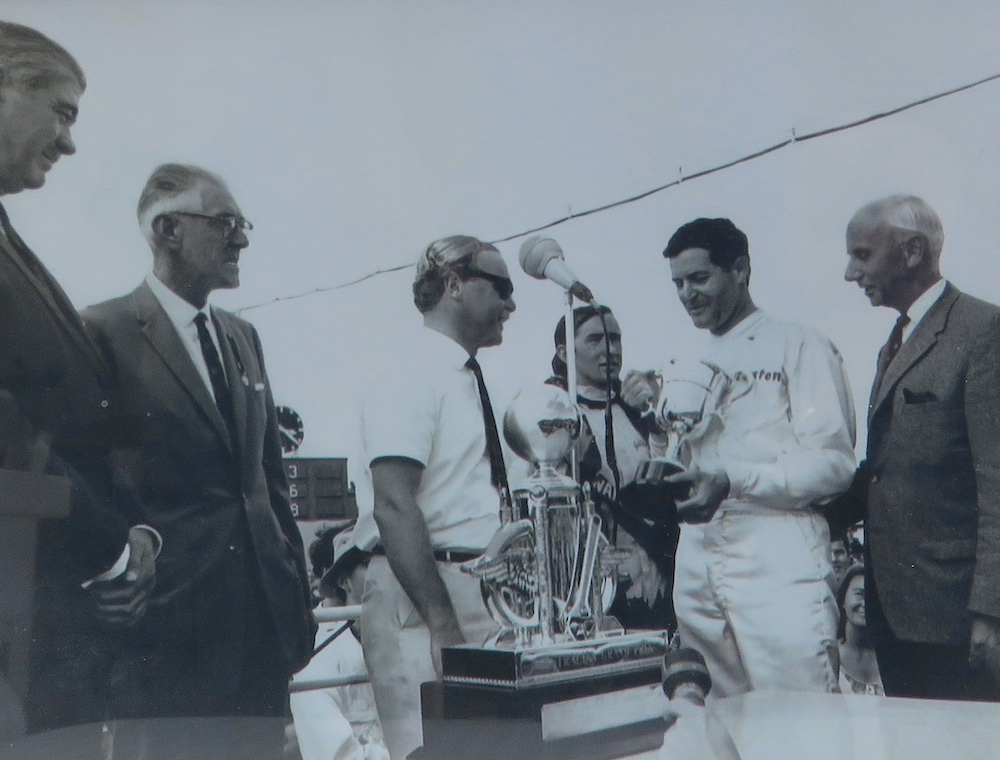
Above: Langridge at centre
presenting his eponymous cup to Leo Geoghegan.
Note F1 champion Jackie Stewart in the
background.
I decided to give a cup for the
first resident Australian driver to finish in the
Australian Grand Prix (AGP). These were the people
who supported racing for the whole year but could
never be on the rostrum in their home Grand Prix
thanks to all the international drivers. CAMS (now
Motorsport Australia) accepted my offer and named
the trophy the Langridge Cup. It was presented at
the AGP at Warwick Farm and was won by Leo Geoghan
after a fantastic dice with Spencer Martin. Jackie
Stewart won the race. I had the privilege of
presenting the initial cup to Leo.
He subsequently won the cup three
times and kept it. Then it was replaced with
another that I believe was presented until the
International F1 Grand Prix commenced in Adelaide
in 1985.
***
-------------------------------------------------
Produced by AllMoto abn 61 400 694 722
Privacy: we do not collect cookies or any other data.

Archives
Contact




